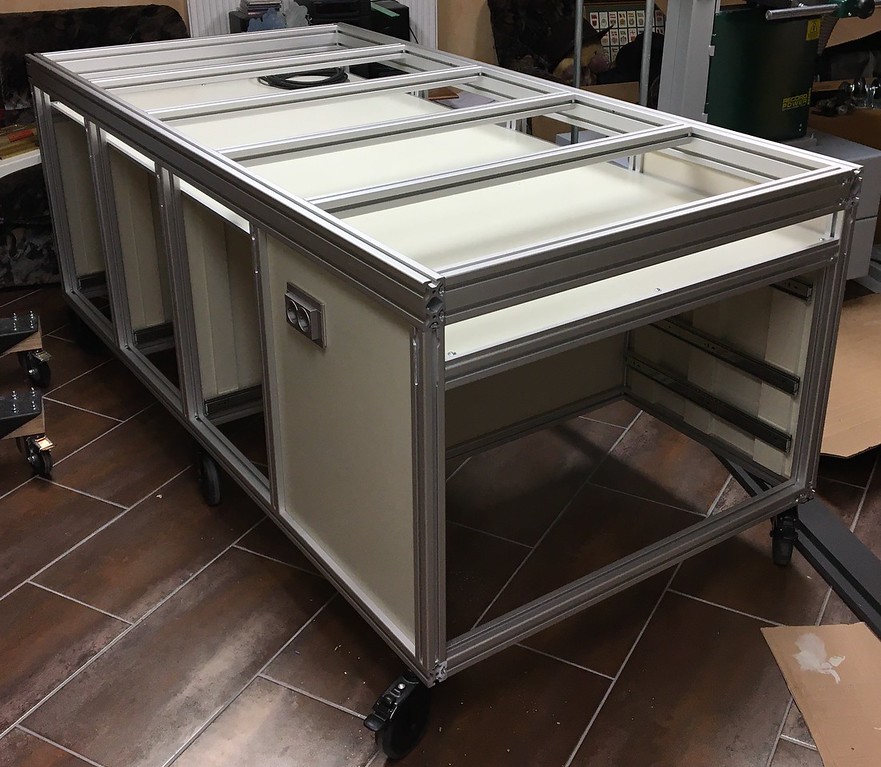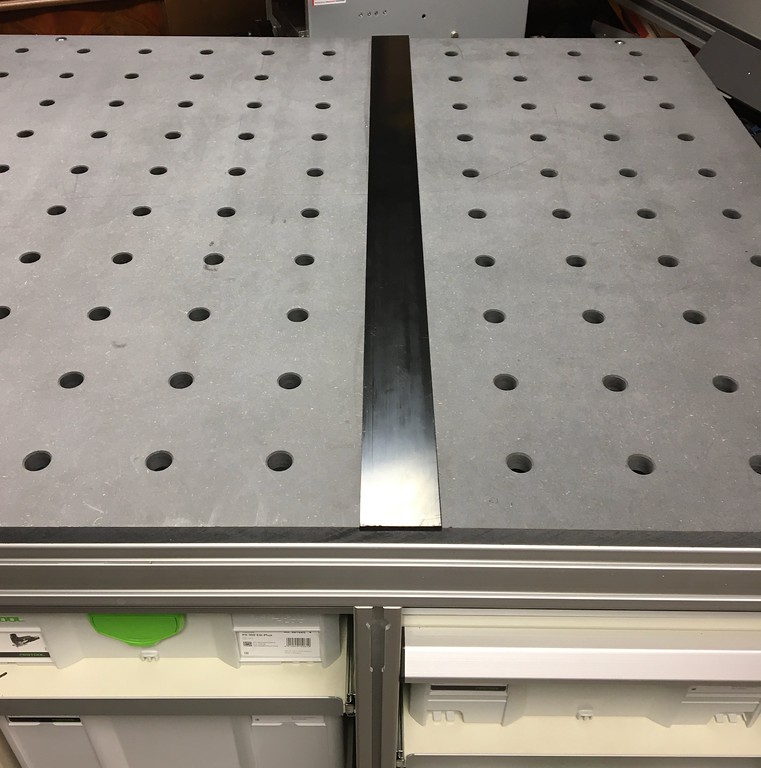niemeyjt
Established Member
As no-one has mentioned it, this guy uses a 100mm spacing: -
It seems he then uses spacers for his cutting.
It seems he then uses spacers for his cutting.

If you have an MFT and dogs, why do you need a square?
As others wrote, the choice of 96mm or 100mm depends on what you plan on using with the worksurface. If you are going to use the hole grid as an alignment pattern for bench dogs and rails, it doesn't make any difference. I used the UJK Parf Guide to make the holes in my top, so it has a 96mm pattern. However, so far I would have been just as happy with a 100mm pattern.
When selecting the thickness of the top, consider what kind of clamps you will be using. If you use the Festool or Bessey clamps that fit through the holes and clamp the work piece to the surface, a thick top might not allow the clamp to pass through the table without chamfering the bottom of the holes. I don't have any problems with the 19mm top, but I have a small worktable in my garage that is about 22mm thick that won't work with the clamps because they can't make the bend through the holes. I haven't been bothered to chamfer the holes because it is small enough that I can use F-clamps along the edges to hold the work piece.
Give some consideration to the width of the table and how many times you might be reaching across the 1.2 meter width. My MFT-style workbench is one meter wide and two meters long. I have not needed the full width for any projects yet and normally put the fence near the middle of the table when cutting with the tracksaw. The width is perfect for the FS 1400/2 guide rail and gives me plenty of overlap should I ever need to cut a one-meter width.
Think about the dimension and location of the cross support beams for the top will be so they don't interfere with the dog holes. Here is an image of my workbench without the top. The workbench is also my assembly table and I am not gentle with it. I didn't want to risk breaking the 19mm Valchromat top, so I put four 40x40mm cross beams along the length of the table.

Here is an image of the unfinished top with the sacrificial HDPE strip. The strip runs along a row of holes and the track saw guide rail is slightly off center. This allows me to rotate the strip 180 degrees when it becomes too chewed up from the saw. I have five spare strips, so I should be good for a few years.

Thanks for the replies all, much appreciated...
The holes pitch is 100mm and the holes either side of the recess are 200mm apart to keep the overall pitch. The recess is 100mm wide and 13mm deep (currently modelled on a 22mm sheet)...
Is there any thing I'm missing at this point or is there anything I should think about adding etc before I get this quoted?





Very nice table Mike. Can I ask where you bought the extrusions from and would you recommend them?
Can't think of a reason to use 100mm over 96 and 96 is so ubiquitous that it's just got to be simpler going the same route? Though apart from a few accessories you can use, 100mm is fine too.
As for the above, no reason you can't do the exact same thing with a 96mm spacing. Sure you need to do minor maths to make your setup blocks, but you only make them once and then write on them what they do.
Depends on the size of your MFT and where you might use a square. My MFT isn't big enough to use for a full sheet, so a square solves that problem. I might also not have an MFT if I'm not in my workshop. A rail square can easily travel with you.
I have a couple of benches made from similar extrusion, purchased in a trading estate in Asia and brought back as part of my luggage allowance over a couple of trips. It was far cheaper there than it is in Europe. The seller had a pendulum / upcut TCT saw and happily sliced everything to size for me while I went for a coffee. I cannot feel any variation in length at all when I put the pieces together. That's significantly better than 1/10mm consistency and helps you to assemble a tight / square bench.There are plenty of places to buy the bulk extrusion and hardware in Germany and the UK, but this would require me to cut, drill, and tap each piece. I can certainly do this, but I can't compete with the accuracy, speed, cleanliness, and cost of having the vendor do this. I don't remember the exact difference in price, but I think all of the machining added about €275 to the cost of the material and hardware.
Enter your email address to join: